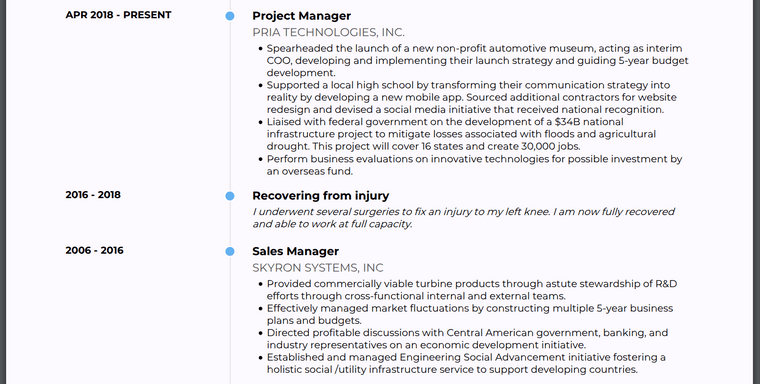
How to explain gaps in work history (in your resume and in the interview)

A gap in your work history doesn’t have to be a red flag. You may have taken time off to attend classes, to travel, or to care for your family. Employers know that there are many reasons for gaps in your resume, and they’re willing to listen to your story.
You still need to be able to explain the gaps, however. While there are many perfectly acceptable reasons to take time away from work, a mysterious absence with no explanation could raise suspicion. In both your resume and in job interviews, you will have to give reasons for any long gaps in your work history.
Here’s how you can explain gaps in your work history to employers and score your next role.
Explaining work history gaps in your resume
It’s important not to obscure long gaps or lie about dates in your resume. All dates can be verified easily. You don’t want to get through the application process only for the employer to discover that you lied when they call your references.
One or two lines that explain why there is a gap in your work history is enough. Greater detail can be given in the interview. Keep it true, and keep it simple.
Give a quick explanation
As long as your explanation is enough to let the employer know you weren’t just lying around, your description can be short and simple. Over-explaining will take up space that will be better used by making your actual work experience as impressive as possible.
2016 - 2019 Stay-at-home parent All children are now enrolled in school and I am returning to work full-time.
2016 - 2017 Recovering from injury I underwent several surgeries to fix an injury to my left knee. I am now fully recovered and able to work at full capacity.

Use the right resume format
Even if the gap in your work history is easy to explain, a long gap can look strange in a reverse-chronological resume. If this is the case, you may want to emphasize your skills over your work history by using a different resume format.
For most job-seekers, a combination resume is a great way of doing this. A combination resume combines the best qualities of a reverse-chronological resume and a functional resume by placing emphasis on skills, but maintaining a reverse-chronological work history section.
Use years instead of months
If the gap between jobs is only two or three months long, an explanation may not be required. It’s normal for a job search to take a few months, so there is no reason to draw attention to it.
In fact, if you have spent several years in most of your roles, you can get away with omitting months from your resume entirely. If you generally spend several years in each role, giving only the years you were employed isn’t misleading. Even if there was a brief period of unemployment between roles, this still shows that you are capable of keeping a role for a long time.
2010 - 2015 Customer Success Manager 2015 - 2020 Customer Service Specialist

For shorter lengths of time, however, this will not work. When you only spend a year or so in each role, overlooked dates can look like job-hopping, or obscure the length of time spent in each role.
2018 - 2019 Customer Success Manager 2019 - 2020 Customer Service Specialist
Use a cover letter
If the gap in your work history is particularly notable, you may want to use a cover letter to explain it. This may not be necessary, as breaks from work aren’t that unusual, but if you feel that the gap is an integral part of your career journey it could help to explain it in the cover letter.
If you are returning to work after spending two years travelling abroad, or five years raising children, for example, this is a part of your story. Just be sure to make it clear that that time in your life is over, and you are ready to commit fully to your next job.
Account for the gap elsewhere in your resume
If you took classes, volunteered, or held part-time roles during your time off, you can include this in your resume. If the years missing in your Work Experience section are filled in by the Volunteering or Education sections, the gap isn’t much of a gap at all.
Have a great resume
If your resume is otherwise perfect, a gap in your work history shouldn’t be a problem. Make sure you have the right experience, that your resume is perfectly tailored to the position, and that you can show the unique skills you bring to the role. Great references or referrals are also helpful.
Explaining work history gaps in a job interview
If your work history contains a gap, employers are going to ask about it, even if it’s explained in the resume. They aren’t trying to sabotage you or catch you off guard; they just want a full picture of your career history. It’s important to have an explanation ready before your interview begins.
Have your story ready
In the interview, you can provide details that your resume did not include. If you have a story prepared that ties the gap into your life, your values, and your career journey, you can make it a positive aspect of your candidacy.
Even if your time away from work was a difficult period or simply a vacation, you can turn it into a marketable story about yourself by framing it in terms of personal growth.
I took time off work to travel across Europe by train. I love meeting people and having new experiences. I learned a lot about communication, scheduling, and budgeting, and I had a lot of fun. It was a rewarding experience and I learned a lot about myself, but I always knew I wanted to come back to work.
Stay focused on the present, and make it clear that that time in your life has ended and you are now committed to working for the long term.
Focus on your skill set
Taking time away from work to care for a family member or travel abroad may seem unrelated to your career, but these are still situations where you can develop organizational skills, communication, leadership abilities, and much more. There is something to be learned from any experience.
Try to come up with transferable skills that you can apply to the new role, and mention these in the interview.
Be positive
It’s important to frame the story of your work history gap in a positive light. Even if the reason for the gap is a negative one, you can emphasize your optimistic outlook and make it clear that the bad experience is over and you are excited to get back to work. This is an opportunity to talk about your goals, your values, and your growth.
I was laid off when my department was put under new management. It was a frustrating experience, but in the following months I was able to take a step back and think about what my values are, what my skill set is, and what I want the next phase of my career to be. I interviewed at dozens of companies before I found one that I thought was the right fit for me. It took a little longer than expected, but I’m happier with my career now than I was when I was laid off.


Written By
Ben Temple
Community Success Manager & CV Writing Expert
Ben is a writer, customer success manager and CV writing expert with over 5 years of experience helping job-seekers create their best careers. He believes in the importance of a great resume summary and the power of coffee.

Don't let these red flags get in the way of your application. With this guide to CV red flags, you will know what problems to look out for and how to fix them.
October 2, 2020
Read Post

Community Success Manager & CV Writing Expert

Amazing tips that will help you remove all the unnecessary clutter from your CV (accompanied by some very actionable and practical advice).
October 5, 2020
Read Post

Community Success Manager & CV Writing Expert

These six tips will have you interviewing for your dream job in no time
November 6, 2019
Read Post

Marketing
Copyright ©2025 Workstory Inc.